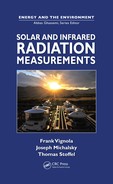Book Description
The rather specialized field of solar and infrared radiation measurement has become more and more important in the face of growing demands by the renewable energy and climate change research communities for data that are more accurate and have increased temporal and spatial resolution. Updating decades of acquired knowledge in the field, Solar and Infrared Radiation Measurements details the strengths and weaknesses of instruments used to conduct such solar and infrared radiation measurements.
Topics covered include:
- Radiometer design and performance
- Equipment calibration, installation, operation, and maintenance
- Data quality assessment
- Methods to use measured data to estimate irradiance for any surface
With a broad range of content that will benefit students and more experienced readers alike, this resource serves as a primer and technical reference that presents the basic terminology and fundamentals for resource assessment. It explores the history of solar radiation instruments and addresses direct normal, global, diffuse, and tilted measurements, as well as the characteristics of instruments used for these measurements. The authors consider methods of assessing the uncertainty of solar measurements and then cover albedo, infrared, net, and spectral irradiance measurements and instrumentation. The book devotes a section to other meteorological instruments, and another to the basics for installing and operating a solar monitoring station. Appendices include information on solar resource assessment modeling and satellite-derived irradiance, along with other useful material.
This book’s authors are experts who each have more than 30 years of experience developing and operating multiple measurement stations, working with industry to improve radiometry, and conducting various research projects.
Table of Contents
- Cover
- Title Page
- Copyright
- Contents
- Chapter 1 Measuring Solar and Infrared Radiation
- Chapter 2 Solar Resource Definitions and Terminology
- 2.1 Introduction
- 2.2 The Sun
- 2.3 Extraterrestrial Radiation
- 2.4 Solar Coordinates
- 2.5 Zenith, Azimuth, and Hour Angles
- 2.6 Solar, Universal, and Local Standard Time
- 2.7 Solar Position Calculation
- 2.8 Sunrise and Sunset Times
- 2.9 Global, Direct Normal, and Diffuse Irradiance
- 2.10 Solar Radiation on Tilted Surfaces
- 2.11 Spectral Nature of Solar Radiation
- 2.12 Fundamentals of Thermodynamics and Heat Transfer
- 2.14 Models
- Questions
- Chapter 3 Historic Milestones in Solar and Infrared Radiation Measurement
- 3.1 Introduction
- 3.2 Earliest Observations of the Sun and The Nature of Light
- 3.3 Nineteenth-Century Radiometers
- 3.4 Operational Radiometers of the Twentieth Century
- 3.4.1 ABBOT SILVER-DISK PYRHELIOMETER (1906)
- 3.4.2 SMITHSONIAN WATER-FLOW PYRHELIOMETER (1910)
- 3.4.3 MARVIN PYRHELIOMETER (1910)
- 3.4.4 ÅNGSTRÖM PYRANOMETER (1919)
- 3.4.5 KIPP & ZONEN SOLARIMETER (1924)
- 3.4.6 ROBITZSCH BIMETALLIC ACTINOGRAPH (1932)
- 3.4.7 EPPLEY 180O PYRHELIOMETER (1930)
- 3.4.8 EPPLEY MODEL PSP (1957)
- 3.4.9 YANISHEVSKY PYRANOMETER (1957)
- 3.4.10 EPPLEY MODEL NIP (1957)
- 3.4.11 EPPLEY MODEL FIR (1968)
- 3.4.12 PRIMARY ABSOLUTE CAVITY RADIOMETER (PACRAD) (1969)
- 3.4.13 EPPLEY MODEL 8–48 (1969)
- 3.4.14 LI-COR MODEL LI-200SA (1971)
- 3.4.15 ROTATING SHADOWBAND RADIOMETER (1975)
- 3.4.16 WORLD STANDARD GROUP (1979)
- 3.5 Recent Advances in Solar Measurements
- Summary
- Questions
- Chapter 4 Direct Normal Irradiance
- 4.1 Overview of Direct Normal Irradiance
- 4.2 Pyrheliometer Geometry
- 4.3 Operational Thermopile Pyrheliometers
- 4.4 Absolute Cavity Radiometers
- 4.5 Uncertainty Analysis for Pyrheliometer Calibration
- 4.6 Uncertainty Analysis for Operational Thermopile Pyrheliometers
- 4.7 Uncertainty Analysis for Rotating Shadowband Radiometer Measurements of Direct Normal Irradiance
- 4.8 Direct Normal Irradiance Models
- 4.9 Historical and Current Surface-Measured Direct Normal Irradiance Data
- Questions
- Chapter 5 Measuring Global Irradiance
- Chapter 6 Diffuse Irradiance
- Chapter 7 Rotating Shadowband Radiometers
- Chapter 8 Measuring Solar Radiation on a Tilted Surface
- 8.1 Introduction
- 8.2 Effect of Tilt on Single Black Detector Pyranometers
- 8.3 Effect of Tilt on Black-and-White Pyranometers
- 8.4 Effect of Tilt on Photodiode Pyranometers
- 8.5 Recommendations for Tilted Irradiance Measurements
- 8.6 Notes on Modeling PV System Performance With Data From Photodiode Pyranometers
- Questions
- Chapter 9 Albedo
- Chapter 10 Infrared Measurements
- Chapter 11 Net Radiation Measurements
- Chapter 12 Solar Spectral Measurements
- Chapter 13 Meteorological Measurements
- Chapter 14 Setting Up a Solar Monitoring Station
- 14.1 Introduction
- 14.2 Choosing A Site
- 14.3 Grounding and Shielding
- 14.4 Data Logger and Communications
- 14.5 Measurement Interval
- 14.6 Cleaning and Maintenance
- 14.7 Record Keeping
- 14.8 Importance of Reviewing Data
- 14.9 Quality Control of Data
- 14.10 Field Calibrations
- 14.11 Physical Layout of a Solar-Monitoring Station
- Questions
- Appendix A: Modeling Solar Radiation
- Appendix B: Solar Radiation Estimates Derived from Satellite Measurements
- Appendix C: Sun Path Charts
- Appendix D: Solar Position Algorithms
- Appendix E: Useful Conversion Factors
- Appendix F: Sources for Equipment
- Appendix G: BORCAL Report
- Appendix H: Sunshine Duration
- Appendix I: Failure Modes
- Index
